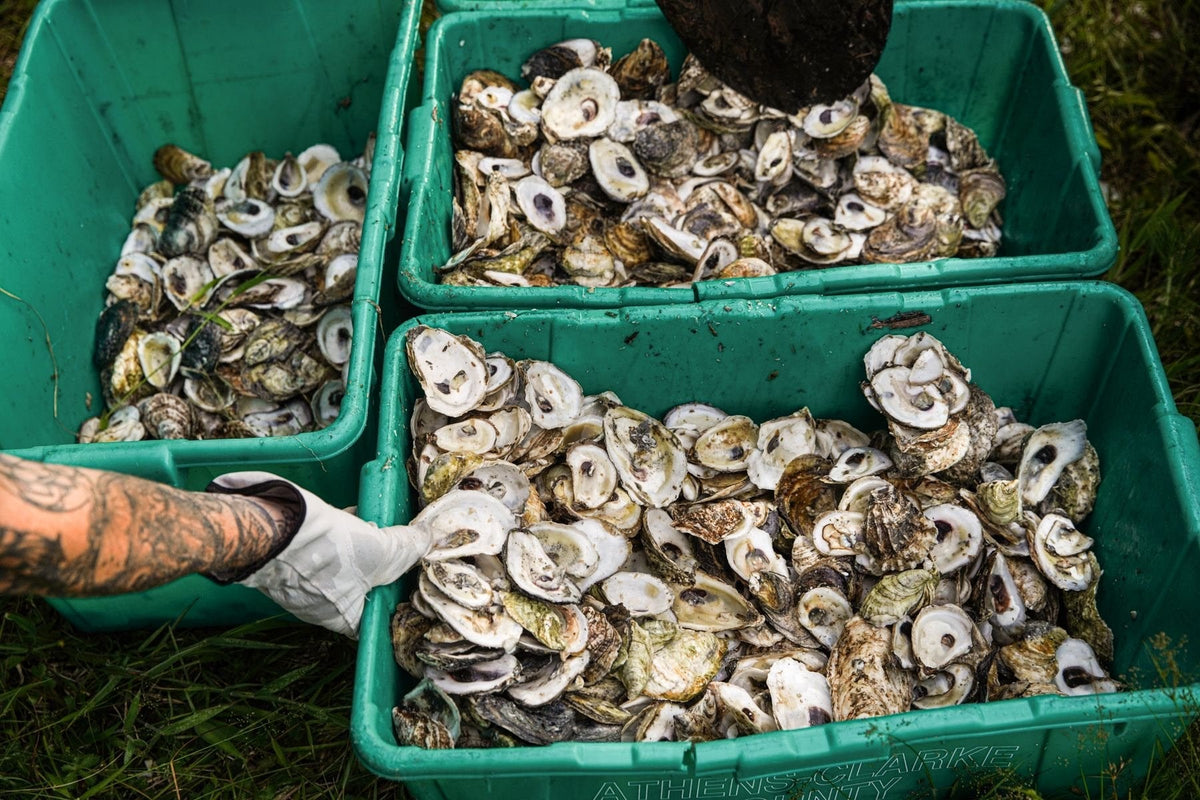
“Shells Aren’t Trash”: How Shell to Shore is Reclaiming Georgia’s Coasts
|
|
Time to read 4 min
|
|
Time to read 4 min
Across the country, there are countless initiatives working to reduce human footprint and protect our natural world. Just south of Toadfish, in the state of Georgia, one impressive nonprofit is doing just that—with something many folks wouldn’t think twice about tossing in the trash. Meet Shell to Shore, an Athens-based conservation initiative that’s turning oyster shells into a powerful tool for coastal restoration. Their mission is simple: keep shells out of landfills and put ‘em back in the water, where they can reinforce shorelines, filter pollutants out of our waters, and support resident marine life.
We here at Toadfish are extremely proud to support their work. We’ve partnered with Shell to Shore to provide co-branded 5-gallon buckets to their restaurant partners—streamlining the shell collection process and helping expand their impact across the state. Let’s take a closer look at the work they’re doing, why it matters, and how this partnership is helping build a more resilient Georgia coastline.
Shell to Shore started with a simple observation: oyster shells were piling up behind one of the most popular oyster bars in Athens, and no one was doing anything with them. Co-founders Hunt Revell and Tyler Leslie saw an opportunity—and ran with it. What began as a grassroots project has grown into a full-fledged conservation effort, now collecting used shells from over 34 restaurants and numerous events in cities like Athens, Atlanta, Augusta, Savannah, and more. Once collected, the shells are delivered to curing stations, where they undergo a six-month “quarantining” process, exposed to sun and rain. This step naturally removes bacteria and organic matter, making the shells safe (and legal) for reuse in local waters. Finally, the clean shells are transported to the coast, where they’re put to work in large-scale restoration projects, serving as the foundation for new oyster reefs and living shorelines.
To understand why shell recycling is so important, you have to understand the oyster, so here are some quick facts.
Recycled oyster shells are essential to building coastal restoration projects. They give tiny, juvenile oysters—called spat—a hard, calcium-rich surface to settle on and grow. Without recycled shell, restoration efforts lose some efficacy, but, with it, they take off. Shell to Shore has already collected and recycled over 250,000 pounds of oyster shell. And now, their first major reef restoration project is underway on Sapelo Island!
At Toadfish, our mission has always been to “Put ’Em Back”—to protect and restore coastal ecosystems through oyster reef restoration. So when we learned about Shell to Shore’s work, we knew we wanted to be part of it. Our contribution is simple but impactful: we’re providing co-branded 5-gallon buckets to help restaurants collect shells more efficiently. These buckets help Shell to Shore scale their collection efforts, especially in high-volume cities like Atlanta, and increase visibility for the program. That visibility matters. With more eyes on the mission, Shell to Shore is building momentum, forging new partnerships, and even exploring major collaborations to improve logistics and shell recovery at scale.
When people, purpose, and the right tools come together, good things happen. Shell to Shore is proving that local action—collecting something as small and ordinary as a discarded oyster shell—can lead to big results. We’re proud to stand alongside them, providing support, spreading the word, and investing in a cleaner, stronger future for Georgia’s coastline. Shell to Shore’s work is part of a bigger picture: a growing network of people and organizations working toward cleaner waters, healthier habitats, and stronger coastal ecosystems.
The partnership between Toadfish and Shell to Shore is just getting started, and we can’t wait to see how far it goes! To Support Shell to Shore, click below!
https://www.shelltoshore.com
Question 1
Lorem ipsum dolor sit amet consectetur adipisicing elit. Illum neque eaque, autem sit soluta, voluptatum libero magnam tempore ullam at harum vel, ad reprehenderit, nemo veniam quas in voluptas hic. Lorem ipsum dolor, sit amet consectetur adipisicing elit. Natus id officia omnis suscipit aut architecto repellat a quia eaque reiciendis blanditiis perferendis hic, nihil, mollitia. Iste velit aperiam, numquam dolorem.
Question 2
Lorem ipsum dolor sit amet consectetur adipisicing elit. Illum neque eaque, autem sit soluta, voluptatum libero magnam tempore ullam at harum vel, ad reprehenderit, nemo veniam quas in voluptas hic. Lorem ipsum dolor, sit amet consectetur adipisicing elit. Natus id officia omnis suscipit aut architecto repellat a quia eaque reiciendis blanditiis perferendis hic, nihil, mollitia. Iste velit aperiam, numquam dolorem.


